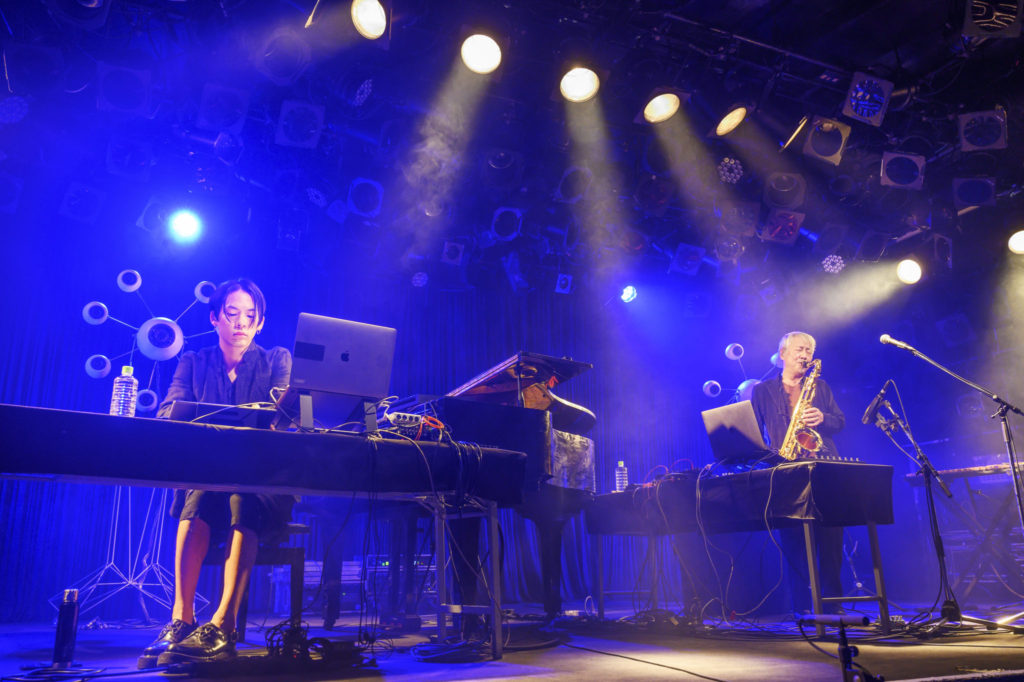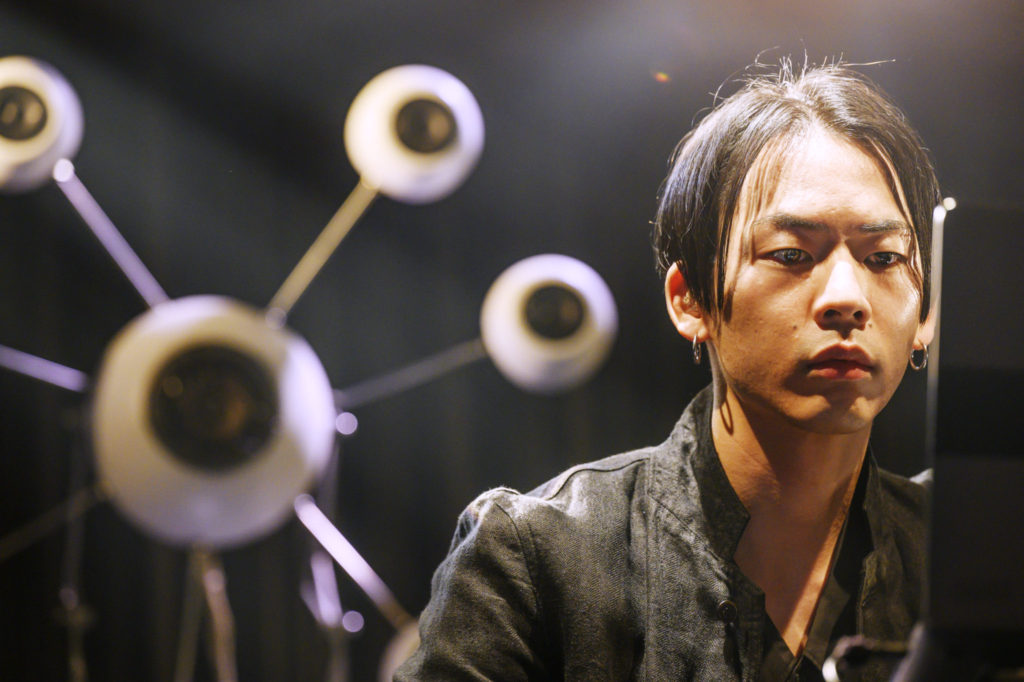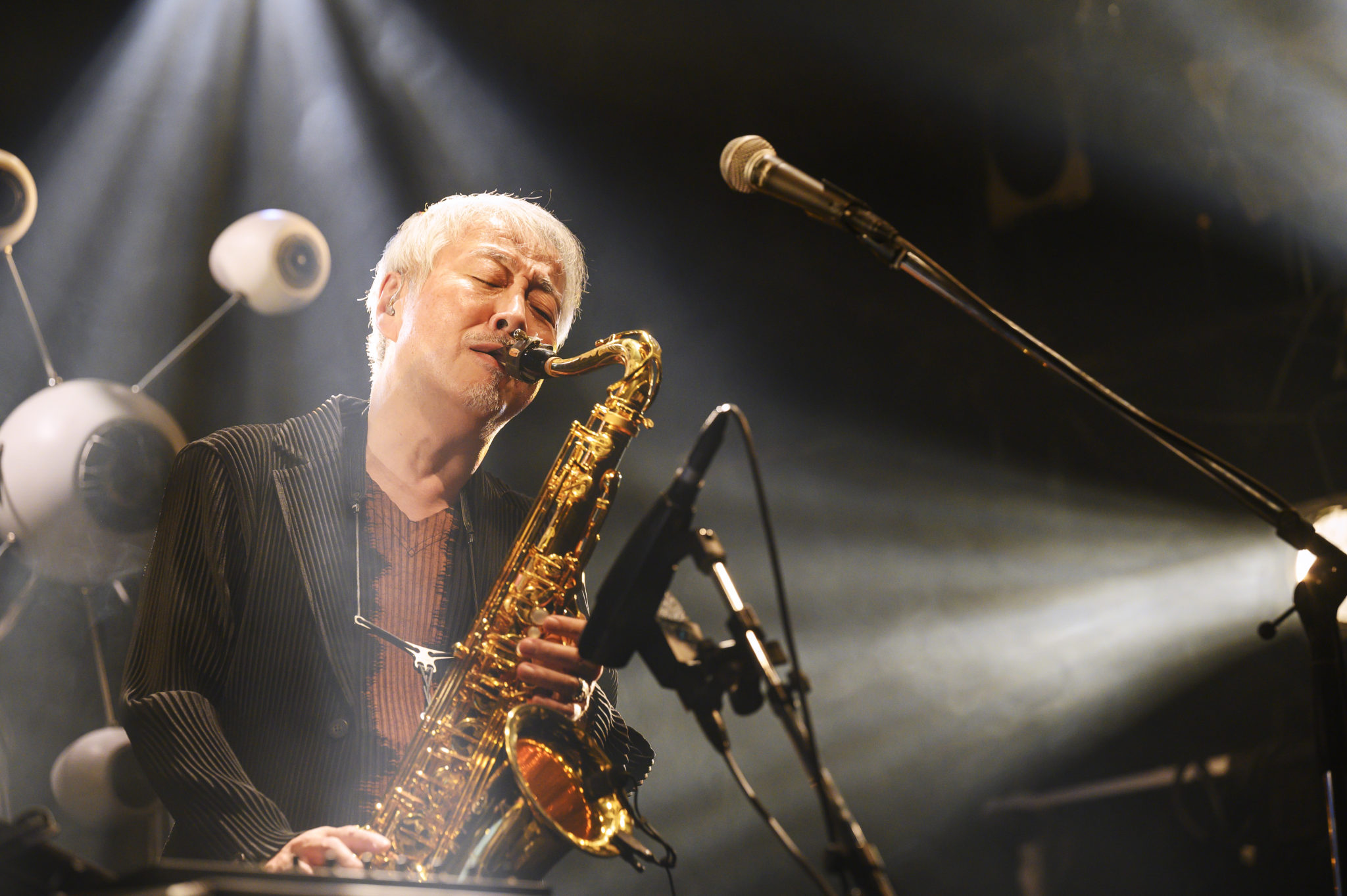Editor, president of Gutenberg Orchestra Co., Ltd. Born in Miyazaki in 1964, he is a former editor in chief of the magazines Composite, Invitation, and Ecocolo. He edits books and magazines and engages in planning and consulting. As a writer, he has released 10 titles including “A Way of Edit” and “World without Desire.” He also manages the independent art book label “United Vagabonds” and received an Ihei Kimura Photo Award for Mari Katayama’s “Gift.” Sugatsuke presides over the “Editing Sparta Seminar” at B&B Shimokitazawa and “Tokyo Art Junior High” at Shibuya Parco. He is a professor at Tohoku University of Arts and Design and the recipient of a NYADC Silver Award and a D&AD Award London.
Photo by Masataka Ishida
Yasuaki Shimizu: User of an impaired instrument and the most free-spirited musician of all
Ever since the invention of electronic instruments, especially synthesizers, the ability of a musician to play one particular instrument has come to be seen not only as an advantage, but also as a hindrance. And with the spread of sequencers and computer programming, training to play a specific instrument, be it piano, guitar, bass, or drums, seems an anachronistic pursuit. In an age where tone and even performance can be programmed by a machine, what is the present value of a superbly skilled player? This is a question that anyone playing music must grapple with nowadays.
One musician who has continuously sought to tackle this dilemma is Yasuaki Shimizu, one of Japan’s leading saxophonists as well as an accomplished composer and music producer. He made his debut as a jazz performer in the ’70s, and in the first half of the ’80s emerged as the frontman of the rock band (if it can be called that) Mariah. Shimizu went on to focus on his solo career in the latter half of the ’80s and, as if renouncing the label of saxophonist, transformed into a multi-talented creator with a voracious appetite for influences ranging from foreign musicians to world music. Among his releases, this was particularly apparent on the 1988 album “Dementos” and the following year’s “Aduna.”
Of course, no matter what musical style he delves into, Shimizu never stops being a saxophonist. His initiatives that began in 1996 with Bach’s unaccompanied “Cello Suites” as their subject matter can, through his outstanding ability as a saxophone player but also as someone exploring the meaning of playing the sax in our present age and in terms of exploring new layers of the instrument itself, be viewed as an act of rethinking music itself, going beyond Bach’s scruffy, scripture-like quality. Music is, after all, the design of sound. In the liner notes of “Cello Suites 1.2.3,” Shimizu writes:
“Some critics say that the popular impression of Bach is that of a grand composer of sublime music, music for bourgeois ladies, but that his work was in fact considered secular in his own time…I thought playing such a master’s lofty music, stuff for bourgeois ladies…on the tenor saxophone would make it even more exciting.” Shimizu’s music exists at the intersection of such timeless sublimity and greatness on one hand, and secular “excitement” on the other.
Shimizu’s “Cello Suites” are distinguished by the uniqueness of their sound. This is due not only to the superb virtuosity of the saxophonist, but also to the reverberations of the huge chambers in which the work was recorded: places such as the giant underground halls of the Oya Quarry in Utsunomiya, the Kamaishi Mine, and the Villa Contarini in Italy, spaces through which the reverberations echo and give the music a cosmic resonance. It is natural dub, so to speak, surpassing even that of Lee “Scratch” Perry and Mad Professor. Bach’s classics are transformed into the sound of another dimension thanks to Shimizu’s extraordinary technique, the aforementioned unique environments, and modern-day recording technology.
In recent years, record labels in the Americas and Europe—the U.S. imprint Palto Flats and Switzerland’s WRWRFWW—have been reissuing several of Shimizu’s solo and Mariah albums in analog format. His reputation in the West skyrocketing, Shimizu embarked on a solo tour of Europe in 2018, covering six countries in the course of ten shows. Upon his return, he was scheduled to perform a “welcome back” concert in Japan, but was forced to postpone due to the pandemic.

Photo by Masataka Ishida
The triumph finally took place at Shibuya Club Quattro on December 12, 2022. This was the last of three shows in a border-crossing concert series called “Beyond,” and Shimizu took to the stage accompanied only by computer player-keyboardist Ray Kunimoto.

Photo by Masataka Ishida
The program consisted of four tracks from Shimizu’s solo album “Kakashi,” two from Mariah’s “Utakata no Hibi,” and three from “Pentatonica” by Yasuaki Shimizu & Saxophonettes. Some of the pieces were taken quite far from their original form, and Shimizu applied a loop delay to his own playing, causing his melodies to overlap one after the other in what sounded like an endless loop.
Nonetheless, the show didn’t fall into the kind of esotericism that characterizes much of contemporary music. Rather, Shimizu pursued a playful, “exciting” sound. This was due in large part to the sensuality of the saxophone, an instrument with many overtones. Shimizu is extremely conscious of the sexiness of the saxophone. One of the highlights of the show was “Tew Semagn Hagere,” a piece of traditional Ethiopian music with Japanese lyrics by Shimizu. This folk tune, which sounded equally like a Japanese ondo (folk songs mainly for dancing) and like the music of the future, blended seamlessly into the performance. You could say that music without any pre-established harmony is one of Shimizu’s main themes. Yasuaki Shimizu is not only a performer, a player; he’s someone capable of playing with sounds in a sophisticated way. Therein lies the freedom in his music, liberated from genre, notation, and programming. This is the most free-spirited music of all, and music that uses the saxophone, an instrument now considered impaired. The show was truly an experience that both defied and lived up to expectations.
Upon witnessing Bach’s superb improvisation on a pipe organ, Johann Adam Reincken, who was Bach’s senior as an organist and known for his strictness with fellow musicians, paid his colleague the following tribute: “I thought this art had died out, but now I see it alive in you.” If we substitute “saxophone” for “this art,” we get a sense of Yasuaki Shimizu’s present position.
The philosopher Jean-Paul Sartre, a great admirer of Bach, described the composer with words fitting for an existentialist: “He taught us how to discover originality within the framework of an established discipline. In fact, he taught us how to live.” As a saxophonist, Yasuaki Shimizu is perhaps the most original musician alive today. He shows us how to be a player and a cerebral musician in the twenty-first century.
Translated by Ilmari Saarinen
INFORMATION
A border-crossing concert series: Beyond vol.3 Asian Soul
Date: 2022.12.12
Venue: SHIBUYA CLUB QUATTRO
Performance by Yasuaki Shimizu (t.sax, voice, radio, effect), Rei Kunimoto (laptop, piano)
Organizer, Planning and Production by Plankton Co. Ltd.,









